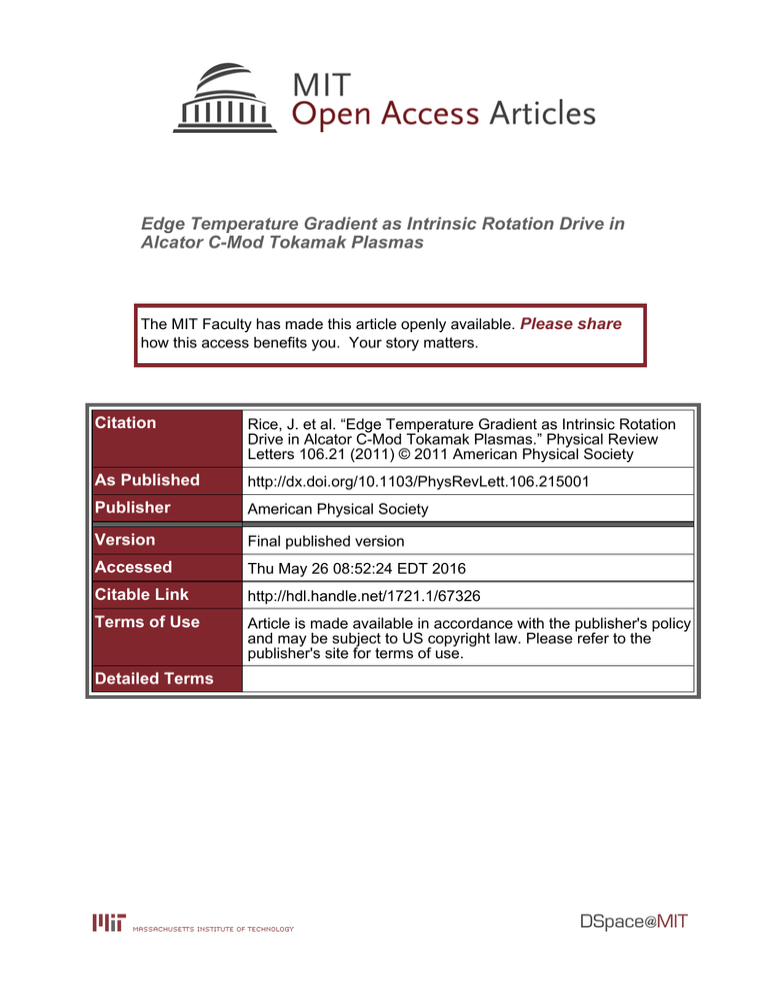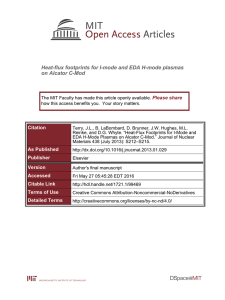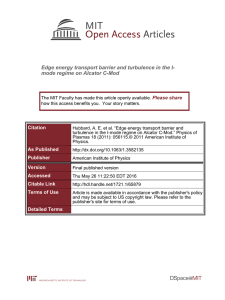Edge Temperature Gradient as Intrinsic Rotation Drive in Please share
advertisement

Edge Temperature Gradient as Intrinsic Rotation Drive in Alcator C-Mod Tokamak Plasmas The MIT Faculty has made this article openly available. Please share how this access benefits you. Your story matters. Citation Rice, J. et al. “Edge Temperature Gradient as Intrinsic Rotation Drive in Alcator C-Mod Tokamak Plasmas.” Physical Review Letters 106.21 (2011) © 2011 American Physical Society As Published http://dx.doi.org/10.1103/PhysRevLett.106.215001 Publisher American Physical Society Version Final published version Accessed Thu May 26 08:52:24 EDT 2016 Citable Link http://hdl.handle.net/1721.1/67326 Terms of Use Article is made available in accordance with the publisher's policy and may be subject to US copyright law. Please refer to the publisher's site for terms of use. Detailed Terms week ending 27 MAY 2011 PHYSICAL REVIEW LETTERS PRL 106, 215001 (2011) Edge Temperature Gradient as Intrinsic Rotation Drive in Alcator C-Mod Tokamak Plasmas J. E. Rice,1 J. W. Hughes,1 P. H. Diamond,2,3 Y. Kosuga,3 Y. A. Podpaly,1 M. L. Reinke,1 M. J. Greenwald,1 Ö. D. Gürcan,4 T. S. Hahm,5 A. E. Hubbard,1 E. S. Marmar,1 C. J. McDevitt,3 and D. G. Whyte1 1 PSFC, MIT, Cambridge, Massachusetts 02139, USA 2 NFRI, Daejeon 305-333, Korea 3 UCSD, San Diego, California 92093, USA 4 LPP Ecole Polytechnique, 91128, Palaiseau, CEDEX, France 5 PPPL, Princeton, New Jersey 08543, USA (Received 2 November 2010; published 23 May 2011) Intrinsic rotation has been observed in I-mode plasmas from the C-Mod tokamak, and is found to be similar to that in H mode, both in its edge origin and in the scaling with global pressure. Since both plasmas have similar edge rT, but completely different edge rn, it may be concluded that the drive of the intrinsic rotation is the edge rT rather than rP. Evidence suggests that the connection between gradients and rotation is the residual stress, and a scaling for the rotation from conversion of free energy to macroscopic flow is calculated. DOI: 10.1103/PhysRevLett.106.215001 PACS numbers: 52.30.q, 52.25.Fi, 52.55.Fa Understanding the mechanism whereby turbulence drives a macroscopic sheared flow is a classical problem in the physics of self-organization. Efforts to understand this phenomenon have motivated development of mean field theory Reynolds stress closure models for convective and MHD turbulence [1]. In tokamaks, sheared toroidal rotation appears spontaneously, seemingly as a result of turbulence driven self acceleration. Rotation and its shear play important roles in the suppression of MHD modes [2] and turbulence [3] in tokamak plasmas. Toroidal rotation is predominantly driven by neutral beams in present day tokamaks, but this method will be much less effective in future devices. An alternative approach is to utilize the self-driven flows (intrinsic rotation) which have been widely observed in plasmas without external momentum input [4]. An understanding of this phenomenon is necessary in order to extrapolate confidently to reactors. Since the transport and relaxation of toroidal momentum is due to turbulence (with =i 1), intrinsic rotation necessarily implies the existence of an agent or element of the momentum flux which can oppose turbulent viscosity. This off-diagonal flux, the residual stress res , is likely responsible for driving intrinsic flow [5]. The connection between observed intrinsic rotation and directly measured res has been demonstrated in CSDX plasmas [6]. Residual stress may be understood as a momentum flux driven by macroscopic gradients which produces a directed bulk flow by converting radial inhomogeneity to broken kk symmetry of the fluctuation spectrum. This process resembles an engine, in that the turbulence converts thermodynamic free energy to macroscopic flow [7]. Several questions arise, the first of which is concerned with the driving gradient. This is a subtle question, since the pressure gradient rP can drive instabilities, break kk 0031-9007=11=106(21)=215001(4) symmetry [8] by its contribution to the zonal flow shear hVE i0 , and also quench turbulence [9] via hVE i0 . Other possibilities include rT and rn. Here, comparison studies of different confinement regimes (H- and I-mode plasmas) are used to isolate the driving gradient. The link between this gradient and the macroscopic flow is res . A simple theory of the intrinsic rotation engine, based on entropy dynamics, is described, and yields a scaling for the intrinsic rotation velocity. Intrinsic rotation has been found to be well correlated with the plasma stored energy in H-mode plasmas [10] in C-Mod and many other devices [4]. This effect is demonstrated in Fig. 1. Following the L- to H-mode transition ( 0:62 s) there were increases in ne , Te ð0Þ, Wp and VTor ð0Þ, the latter determined from the Doppler shifts of x-ray lines. Shown for comparison are the time histories for an I-mode plasma. Both discharges had BT ¼ 5:4 T and IP ¼ 0:8 MA, with similar target densities and heating power. The main difference was that the I-mode plasma was formed with the unfavorable ion B rB drift direction. There was very little change in ne in the I-mode case, and a larger increase in Te . The stored energy in these two discharges was very similar, as was the magnitude of VTor ð0Þ and velocity profile shape. I mode is an operational regime [11] which exhibits H-mode energy confinement with L-mode particle confinement. Shown in Fig. 2 is a comparison of edge profiles from the plasmas of Fig. 1. Both plasmas display an edge energy transport barrier, as manifested by the pedestals in Te at 3 mm inside of the last closed flux surfaces. rT at this location is the same for both plasmas, about 60 keV=m. Only the H-mode discharge has a pedestal in ne , however; in I mode the edge ne profile is similar to that in L mode. That heat and 215001-1 Ó 2011 American Physical Society (kJ) (1020/m3) WP H-mode I-mode n 0.4 Te (keV) 100 80 60 40 20 0 3.0 2.5 2.0 1.5 1.0 0.5 0.0 4 3 2 1 0 60 (km/s) 40 20 (MW) 0 -20 VTor(0) 0.4 2.5 2.0 1.5 1.0 0.5 0.0 0.4 PICRF 0.6 0.8 1.0 t (s) 1.2 1.4 1.6 FIG. 1 (color online). Time histories, from top to bottom, of the plasma stored energy, electron density, electron temperature, rotation velocity (positive denotes cocurrent) and ICRF power, for an H-mode (green dashed) and an I-mode (solid red) plasma. (kPa) 600 500 400 300 200 100 0 14 12 10 8 6 4 2 0 -25 ne (1020/m3) 1.0 0.5 0.0 I-mode 120 100 80 60 40 20 0 2.5 2.0 1.5 1.0 0.5 0.0 (keV) 2.0 1.5 (a) ne (b) Te WP ICRF ne 3 2 1 0 Te 60 VTor 40 (km/s) (eV) (1020/m3) 3.0 2.5 For H-mode plasmas, it has been established that the intrinsic rotation originates at the plasma edge, and propagates in to the core on a momentum confinement time scale [13]. Similar behavior is seen in I-mode plasmas, as shown in Fig. 3. Following the transition to I mode (0.7 s), VTor first appears at the plasma edge, then propagates in to the plasma center. It is well documented that the change in VTor between L and H mode is proportional to the change in the plasma stored energy (normalized to Ip ) [4,10]. Similar behavior is apparent in I mode, as can be seen in Fig. 4. The I-mode points (red asterisks) overlay the H-mode points (green dots) from a large database, suggesting a common phenomenology giving rise to the rotation. Given the evidence that the origin for the intrinsic rotation is in the pedestal region ([13] and Fig. 3), it would be natural to seek a local edge gradient rather than the global stored energy as relevant to the rotation drive. Intrinsic rotation in JT-60U plasmas has been linked to the ion pressure gradient [14]. Shown in Fig. 5(a) is the change in the rotation velocity as a function of the change in the pedestal rP. (In C-Mod plasmas, the edge ion and electron pressure profiles are the same [12].) For the H-mode points, there is a very good correlation between V and edge rP. However, the I-mode points do not coincide, because the rotation is the same while rP is lower than in H mode (as seen in Fig. 2). The two sets of points overlay very well for the pedestal rT, as demonstrated in Fig. 5(b), suggesting that it is rT which is key in driving intrinsic rotation. The association of intrinsic (kJ) particle transport is decoupled in I mode allows a unique opportunity for energy barriers to be studied separately; in H mode both transport channels are usually linked. Since there is no particle barrier in I mode, the edge rP is considerably lower ( 0:7 MPa=m, about a factor of 3 in this comparison) compared to H mode. The pedestal Er well depth is also shallower in I mode compared to H mode [12]. H-mode week ending 27 MAY 2011 PHYSICAL REVIEW LETTERS PRL 106, 215001 (2011) (c) Pe 20 r/a=0.6 r/a=0.0 0 -20 0.6 -20 -15 -10 -5 R - RLCFS (mm) 0 5 10 FIG. 2 (color online). Edge profiles of the electron density (a), electron temperature (b) and electron pressure (c) from the H mode (green dots) and the I mode (red asterisks) discharges of Fig. 1. 0.7 0.8 0.9 t (s) 1.0 1.1 1.2 FIG. 3 (color online). Parameter time histories for an I-mode discharge. In the bottom frame is the normalized chord-averaged toroidal rotation velocity at several radial locations, evenly spaced from r=a ¼ 0:6 to r=a ¼ 0:0. 215001-2 120 electrons, the time evolution of entropy or f2 is given by, apart from boundary terms, 100 @t VTor (km/s) 80 60 40 20 0 0 50 100 WP/IP (kJ/MA) 150 FIG. 4 (color online). The change in the core toroidal rotation from L mode to I mode (red asterisks) and to H mode (green dots) as a function of the change in the stored energy normalized to the plasma current. rotation with the ion temperature gradient has been demonstrated in LHD ITB plasmas [15]. The approach for addressing the origin of intrinsic flow may be cast in terms of fluctuation entropy and describes intrinsic rotation as a thermodynamic engine. In the framework of residual stress, the flow generation process can be understood as a conversion of thermal energy into the kinetic energy of macroscopic flow by drift wave turbulence excited by rT, rn, etc. Using the physical picture of flow generation as an energy conversion, an explicit expression for the efficiency of the conversion process may be formulated by comparing rates of entropy production (destruction) due to thermal relaxation (flow) generation [16]. For a model with drift kinetic ions and adiabatic 100 VTor (km/s) 80 60 40 20 (a) 0 0 week ending 27 MAY 2011 PHYSICAL REVIEW LETTERS PRL 106, 215001 (2011) 1 2 3 4 5 Change in Edge Grad P (MPa/m) (b) 0 50 100 150 200 Change in Edge Grad T (keV/m) FIG. 5 (color online). The change in the core rotation velocity as a function of the change in the pedestal rP (a) and pedestal rT (b) for H-mode (green dots) and I-mode (red asterisks) plasmas. Z d3 vd3 x hf2 i ¼ P Dc : hfi (1) R 0 Here, P d3 xd3 vfhV~r fihfi ðe=mi ÞhE~k fi= R 3 =hfi hfið@hfi=@vk Þg and Dc d xd3 vhfCðfÞi=hfi are the production rate and collisional dissipation of entropy, respectively, following the notation of [16]. Note that the approximation of adiabatic electrons is fairly good, since e 1:3 > 1 and k2k v2the =ð!ei Þ 29:6 1 for k? s 0:2 and for the C-Mod pedestal parameters, Ti Te 200 eV, q 3, A 1=3, n 1020 m3 . Note also that Dc is small compared to the production rate from rT, as Dc =ðni =L2T Þ eff =ðcs =aÞ 0:08 where Dc R d3 xneff je=Te j2 , je=Te j2 2 , i GB and the same parameters were utilized. Hence Dc is dropped hereafter. By modeling flux-gradient relations, the production rate can be reduced to [16] 2 Z rT hV i0 2 P d3 x ni nK E T vthi 2 res2 0 hVk i (2) þ n n 2 rk vthi vthi P where K k c2s ZF ð2s k2 Þ=ð1 þ k2? 2s Þ2 fkr @k =@kr g, k ð1 þ k2? 2s Þ2 j^ k Þj2 . The first term on the right-hand side is the entropy production rate due to thermal relaxation. Note this term is implicitly related to the heat source, as rT is tied to heat input via the heat balance equation. The second term is the entropy destruction rate due to zonal flow generation. Note that this term destroys entropy only when zonal flow grows, i.e., ZF / K > 0. The third term is the entropy production rate due to the relaxation of the velocity gradient. The last term is the entropy destruction rate due to the generation of intrinsic toroidal rotation. Entropy production rate by particle transport, namely hV~r n~ihni0 , is small for adiabatic electrons. The production rate P contains terms with a definite order. The last two terms are smaller than the first two by the order of Oðkk =k? Þ, where k is representative of the mode number of drift waves. Hence a stationary state is achieved by balancing the production and destruction rates order by order. To lowest order, the balance is between the production rate from thermal relaxation and the destruction rate from zonal flow growth. The balance yields hVE i02 ¼ ði =KÞðv2thi =L2T Þ which relates zonal flow strength to rT directly. To the next order, the third and the fourth terms in Eq. (2) cancel since the total parallel momentum vanishes for a stationary state as hV~r V~k i ¼ hVk i0 þ res rk ¼ 0. To calculate hVk i, a model of the residual stress is required. Here, a case is considered where toroidal rotation is driven by a two step process: first, a stationary state is achieved by balancing the entropy production rate due to 215001-3 PRL 106, 215001 (2011) PHYSICAL REVIEW LETTERS thermal relaxation by the entropy destruction due to zonal flow growth. Secondly, the zonal flow E B shear set by the dominant balance gives rise to symmetry breaking and momentum flux via k space scattering. In such a process, the residual stress is calculated as [5,8] 2 Ls Ls rT 02 res ¼ KhV i ¼ v2thi : (3) E rk 2cs 2cs i T The condition hV~r V~k i ¼ 0 implies a strongly nonlinear relation between rVk and rT=T, i.e., res 1 L rT 2 2 vthi : (4) hVk i0 ¼ rk ¼ i s 2 cs T Simple integration then establishes the relation between edge rT and the flow velocity, sffiffiffiffiffi 1 i Ls Ti rT hVk i / pffiffiffiffi ; ffi (5) 2 LT Te vthi T Ip where ðT 0 =TÞ0 ¼ ðT 0 =TÞ2 þ T 00 =T ffi ðT 0 =TÞ2 has been used. The sign conventions here are such that the rotation is predicted to be cocurrent. For typical H- and I-mode discharges in C-Mod, 0:006, Te Ti , =i 1, Ls 0:6 m and LT 0:01 m, Eq. (5) yields a thermal Mach number of 0.18, which is also typical [4]. Equation (5) captures the rT scaling of Fig. 5 from 1=LT and the 1=Ip scaling of Fig. 4 from Ls / q=s^ / 1=Ip . In this Letter, progress toward a physics based phenomenology of intrinsic rotation in H and I mode has been described. The principal results are: there is a close correlation between VT ð0Þ and rTjedge , both in H and I mode. week ending 27 MAY 2011 This, in turn, suggests that the macroscopic scaling VT ð0Þ Wp =Ip may be replaced by a relation expressed in terms of local parameters, i.e., VT ð0Þ rT=B . A theory of the entropy balance for a turbulent plasma is presented, which yields a scaling for the residual stress and the toroidal rotation velocity. The theory predicts that Vk scales with rT and q. The authors thank the C-Mod operations and ICRF groups for expert running of the tokamak. Work supported by DOE Contract No. DE-FC02-99ER54512 at MIT, DEAC02-09CH11466 at PPPL and DE-FG02-04ER54738 at UCSD (CMTFO), the W. C. I. program of MEST, Korea and A. N. R. contract ANR-06-PLAN-0084 in France. [1] [2] [3] [4] [5] [6] [7] [8] [9] [10] [11] [12] [13] [14] [15] [16] 215001-4 U. Frisch et al., Physica (Amsterdam) 28D, 382 (1987). E. J. Strait et al., Phys. Rev. Lett. 74, 2483 (1995). T. S. Hahm, Phys. Plasmas 1, 2940 (1994). J. E. Rice et al., Nucl. Fusion 47, 1618 (2007). P. H. Diamond et al., Nucl. Fusion 49, 045002 (2009). Z. Yan et al., Phys. Rev. Lett. 104, 065002 (2010). Ö. D. Gürcan et al., Phys. Plasmas 17, 032509 (2010). Ö. D. Gürcan et al., Phys. Plasmas 14, 042306 (2007). H. Biglari et al., Phys. Fluids B 2, 1 (1990). J. E. Rice et al., Nucl. Fusion 39, 1175 (1999). D. G. Whyte et al., Nucl. Fusion 50, 105005 (2010). R. M. McDermott et al., Phys. Plasmas 16, 056103 (2009). W. D. Lee et al., Phys. Rev. Lett. 91, 205003 (2003). M. Yoshida et al., Phys. Rev. Lett. 100, 105002 (2008). K. Ida et al., Nucl. Fusion 50, 064007 (2010). Y. Kosuga et al., Phys. Plasmas 17, 102313 (2010).






